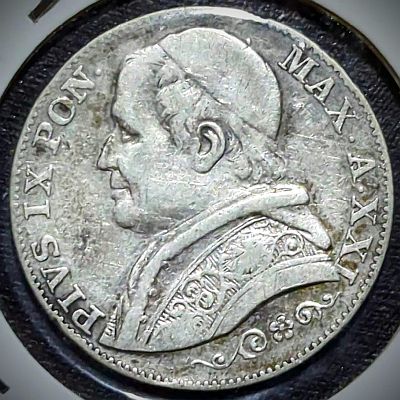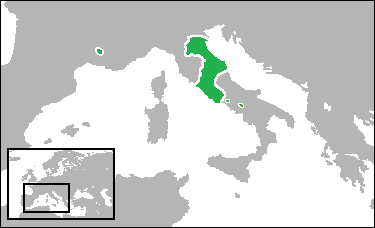One of the last Papal States coins

Pope Pius IX was head of the Catholic Church from 16 June 1846 – 7 February 1878. At over 31 years and 7 months, it is the longest verifiable Papacy. Saint Peter, the first Pope was “head” of the church for 34 or 37 years (30 A.D. to either 64 or 67 A.D., although exact dates aren’t recorded).
For many centuries the Pope, was not only the head of the church, but also controlled “The Papal States”, a swathe of central Italy, which ran as its own country, issued its own currency and fought in wars. Coins featured an image of the pope (pictured above).

During Pope Pius IX tenure there were some very big changes, in the church and in society. The Revolutions of 1848 were a series of revolutions, affecting some 50 countries across Europe, including Italy. At that time, Italy was not one single country as now. Apart from the miniscule principalities of San Marino and Monaco, there were three kingdoms (Sardinia, Lombardy-Ventia and the Kingdom of the two Sicilies), three sovereign duchies, and the extensive temporal possessions of the papacy. In each of these, an autocratic government encountered a revolutionary challenge during 1848.
Not immune to this, the assassination of a close associate of Pope Pius IX and unrest caused the Pope to flee to Gaeta, 120km south. A group of revolutionaries declared “The Roman Republic”. Pope Pius IX asked Catholic countries to invade his former states and reinstate him. After long discussions, the armies of Austria, France, Spain and the Kingdom of the Two Sicilies attacked the republic from all sides. Long story short, though those two previous links are worth reading on it, the Papal States were restored and the Pope returned to Rome. The 1849 republic lasted 5 months.
The restoration of the Papal States was not to last. In 1860, Victor Emmanuel II of Sardinia defeated the papal army in the Battle of Castelfidardo. Victor Emmanuel II took all of the Papal territories except the Latium region of Italy (which included Rome), and declared himself King of Italy. Rome itself was invaded on 20 September 1870.
In 1871 Italy instituted the Law of Guarantees which gave the Pope the use of the Vatican but denied him sovereignty over this territory. Pius rejected this and refused to leave Vatican City, declaring himself a “prisoner in the Vatican”. Nonetheless, the pope no longer had an army and so the Papal States were no more.

The Papal States continued to mint coins right up until 1870. The last four Papal State issues being the 2 and 5 Lire silver coins and the 20 and 50 Lire gold coins. These were all part of a series issued from 1866 comprising of 100 Centesimi = 20 Soldi = 1 Lira. This 2 Lire was issued in 1866, the first of the last issue.
Following the dissolution of the Papal States, coins were not issued in the name of the pope until the creation of Vatican City State. There were pattern 5 Lire pieces created of Pope Leo XIII in 1878, possibly by French friends of the papacy, however these never circulated (and are quite valuable today).


Leave a Reply